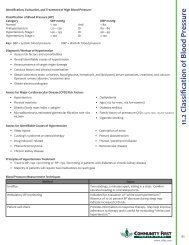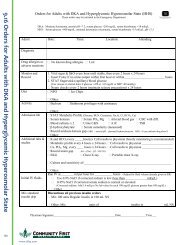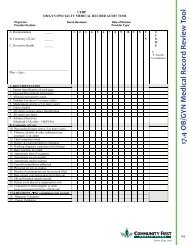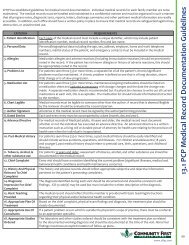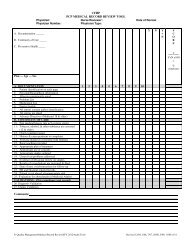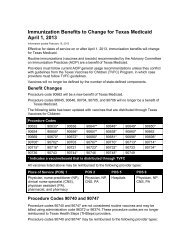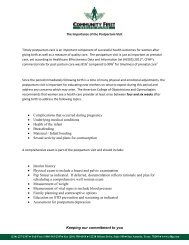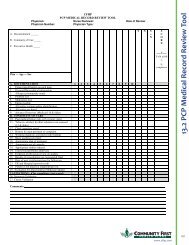Full Clinical Guidelines - Community First Health Plans.
Full Clinical Guidelines - Community First Health Plans.
Full Clinical Guidelines - Community First Health Plans.
Create successful ePaper yourself
Turn your PDF publications into a flip-book with our unique Google optimized e-Paper software.
Risk Factors for Osteoporosis Fractures<br />
www.nof.org<br />
Non-modifiable:<br />
• Personal history of fracture as an adult<br />
• History of fracture in first-degree relative<br />
• Caucasian/Asian race<br />
• Advanced age<br />
• Female sex<br />
• Dementia<br />
• Poor health/frailty<br />
Potentially Modifiable:<br />
• Current cigarette smoking<br />
• Low body weight (1 year)<br />
• Low calcium intake (lifelong)<br />
• Alcoholism<br />
• Impaired eyesight despite correction<br />
• Recurrent falls<br />
• Inadequate physical activity<br />
• Poor health/frailty<br />
• Use of corticosteroid therapy for >3 months<br />
The four items in boldface type are key factors in determining risk of hip fracture independent of BMD.<br />
Who should be tested?<br />
Your healthcare provider may recommend a bone mineral density (BMD) test if you are:<br />
• A postmenopausal woman under age 65 with one or more risk factors for osteoporosis<br />
• A man age 50-70 with one or more risk factors for osteoporosis<br />
• A woman age 65 or older, even without any risk factors<br />
• A man age 70 or older, even without any risk factors<br />
• A woman or man after age 50 who has broken a bone<br />
• A woman going through menopause with certain risk factors<br />
• A postmenopausal woman who has stopped taking estrogen therapy (ET) or hormone therapy (HT)<br />
Some other reasons your healthcare provider may recommend a BMD test:<br />
• Long-term use of certain medications including steroids (for example, prednisone and cortisone), some anti-seizure<br />
medications, Depo-Provera® and aromatase inhibitors (for example, anastrozole, brand name Arimidex®)<br />
• A man receiving certain treatments for prostate cancer<br />
• A woman receiving certain treatments for breast cancer<br />
• Overactive thyroid gland (hyperthyroidism) or taking high doses of thyroid hormone medication<br />
• Overactive parathyroid gland (hyperparathyroidism)<br />
• X-ray of the spine showing a fracture or bone loss<br />
• Back pain with a possible fracture<br />
• Significant loss of height<br />
• Loss of sex hormones at an early age, including early menopause<br />
• Having a disease or condition that can cause bone loss (such as rheumatoid arthritis or anorexia nervosa)<br />
National Osteoporosis Foundation. Physician’s guide to prevention and treatment of osteoporosis. Washington (DC): National Osteoporosis Foundation; 2008,<br />
p.13<br />
Who should be treated?<br />
Postmenopausal women and men age 50 and older presenting with the following should be considered for treatment:<br />
• A hip or vertebral (clinical or morphometric) fracture<br />
• T-score ≤ -2.5 at the femoral neck or spine after appropriate evaluation to exclude secondary causes<br />
• Low bone mass (T-score between -1.0 and -2.5 at the femoral neck or spine) and a 10-year probability of a hip fracture ≥ 3%<br />
or a 10-year probability of a major osteoporosis-related fracture ≥ 20% based on the US-adapted WHO algorithm<br />
14.2 Recommendations from National Osteoporosis Foundation<br />
H EALTH PLANS<br />
www.cfhp.com<br />
109



